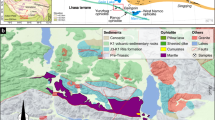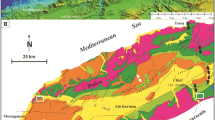Abstract
The diagenesis in the organic-rich Cretaceous to Eocene Al Hisa Phosphorite Formation (AHP), Muwaqqar Chalk Marl Formation (MCM) and Umm Rijam Chert-Limestone Formation (URC) formations of Jordan can be linked directly to the fluctuating sedimentary environment of this shelf depositional system in the Middle to Late Eocene, and its influence on the composition of the deposited sediment and the early burial diagenetic environment. Most cementation was early, mostly within the first 10 m of burial, perhaps entirely within the first 100 m of burial. We propose that the siliceous cements are derived from biogenic silica, probably of diatoms, deposited in a shelf of enhanced productivity. Volumetrically, the most important processes were the redistribution of biogenic opal-A (diatoms) and calcite to form pervasive, layered and nodular cements. The formation of the silica and carbonate cements is closely linked through the effects their dissolution and precipitation have on pore fluid chemistry and pH. The chert beds have a biogenic silica origin, formed through replacement of diatoms and radiolaria by opal-CT, and subsequently by quartz. Calcite cement has carbonate derived from microbial diagenesis of organic matter and calcium derived from seawater. The Mg for early dolomite may have been generated by replacement of opal-CT by quartz, ore dissolution of unstable high Mg calcite bioclasts. The silica and carbonate diagenetic processes are both linked to microbial diagenesis of organic matter, and are intimately linked in both time and space, with pH possibly influencing whether a silica or a carbonate mineral precipitates. The paucity of metal cations capable of precipitating as sulphides is crucial to the creation of acidic pore water favourable to silica precipitation, either as opal-CT, chalcedony or quartz. The lack of clay minerals as a sink for the Mg required for opal-CT polymerisation is the principal factor responsible for the remarkably early silica cementation. All the diagenetic processes, with the probable exception of the opal-CT to quartz transition are early, almost certainly within the first 10 m of burial, possibly much less. A paragenetic sequence is presented here based on these two cores that should be tested against a wider core distribution to see whether this diagenetic history can be generalised throughout the basin. Warm bottom water temperatures probably led to silica diagenesis at much shallower burial depths than occurs in many other sedimentary basins. Silicified layers, in turn, commonly host fractures, suggesting that mechanical properties of the strata began to differentiate at a very early stage in the burial cycle. This has wide implications for processes linking diagenesis to deformation.








Similar content being viewed by others
References
Abed AM, Kraishan GM (1991) Evidence for shallow marine origin of a ‘Monterey Formation type’ chert-phosphorite-dolomite sequence, Amman Formation (late Cretaceous), central Jordan. Facies 24:25–38
Ali Hussein M, Alqudah M, van den Boorn S, Kolonic S, Podlaha O, Mutterlos J (2014a) Eocene oil shales from Jordan—their petrography, carbon and oxygen stable isotopes. Geo Arabia 19:139–162
Ali Hussein M, Alqudah MG, Podlaha OG, van den Boorn S, Kolonic S, Mutterlose J (2014b) Ichnofabrics of Eocene oil shales from central Jordan and their use for paleoenvironmental reconstructions. Geo Arabia 19:145–160
Alqudah M, Ali Hussein MG, Podlaha O, van den Boorn S, Kolonic S, Mutterlose J (2014) Calcareous nannofossil biostratigraphy of Eocene oil shales from central Jordan. Geo Arabia 19:117–140
Aqleh S (2015) Palaeo-environmental reconstruction of Jordanian oil shale based on inorganic geochemical data. Newcastle University, School of Civil Engineering and Geosciences, unpublished PhD dissertation
Baker PA, Kastner M (1981) Constraints on the formation of sedimentary dolomite. Science 213:214–216
Bennett RH, Ransom B, Kastner M, Baerwald RJ, Hulbert MH, Sawyer WB, Olsen H, Lambert MW (1999) Early diagenesis: impact of organic matter on mass physical properties and processes, California continental margin. Mar Geol 159:7–34
Bisque R (1962) Clay polymerisation in carbonate rocks: silicification reaction defined. Abstract, Ninth National Conference on Clays and Clay Minerals, 123
Bohlmann EG, Mesmer RE, Berlinski P (1980) Kinetics of silica deposition from simulated geothermal brines. J Soc Petrol Eng 20:239–248
Clayton CJ (1986) The chemical environment of flint formation in Upper Cretaceous chalk. In: Sieveking GDG, Hart MB (eds) The scientific study of Flint and Chert. Cambridge University Press, Cambridge, pp 43–54
Demaster JD (2003) The diagenesis of biogenic silica: chemical transformations occurring in the water column, seabed, and crust. In: Holland HD, Turekian KK (eds) Treatise on geochemistry, volume 7: Fred T Mackenzie Executive. Elsevier, Amsterdam, pp 87–98
Dove PM (1994) The dissolution kinetics of quartz in sodium chloride solutions at 25 to 300 °C. Amer J Sci 294:665–712
Dove PM (1999) The dissolution kinetics of quartz in aqueous mixed cation solutions. Geochim Cosmochim Acta 63:3715–3727
Elzea JM, Odom IE, Miles WJ (1994) Distinguishing well ordered opal-CT and opal-C from high temperature opal-CT by x-ray diffraction. Anal Chim Acta 286:107–116
Florke OW, Graetsch H, Martin B, Roller K, Wirth R (1991) Nomenclature of microcrystalline and non-crystalline silica minerals, based on structure and microstructure. Neues Jahrb Mineral Abh 163:19–42
Giles MR, de Boer RB (1990) Origin and significance of redistributional secondary porosity. Mar Petrol Geol 7:378–397
Isaacs CM (2014) Influence of rock composition on kinetics of silica phase changes in the Monterey Formation, Santa Barbara area, California. Geology 10:304–308
Kastner M (1981) Silica polymorphs. In: marine minerals, RG Burns (ed) Mineralogical Society of America. Rev Mineral 6:99–107
Kastner M, Keene JB, Giesker JM (1977) Diagenesis of siliceous oozes - 1 Chemical controls on the rate of opal-A to opal CT transformation - an experimental study. Geochim Cosmochim Acta 41:1041–1059
Keller MA, Isaacs CM (1985) An evaluation of temperature scales for silica diagenesis in diatomaceous sequences including a new approach based on the Miocene Monterey Formation, California. Geo-Mar Lett 5:31–35
Kolodny Y, Chaussidon M, Katz A (2005) Geochemistry of a chert breccia. Geochim. Cosmochim Acta 69:427–439
Kolodny, Y, Garrison, R (1994) Sedimentation and diagenesis in palaeo-upwelling zones of epeiric seas and platformal settings: a comparison of the Cretaceous Mishash Formation of Israel and the Miocene Monterey Formation of California. In A. Iijama, A.M. Abed and R. Garrison (Eds), Siliceous, phosphatic and glauconitic sediments in the Tertiary and Mesozoic. Proceedings of the 29th International Geological Congress, Part C. VSP, The Netherlands, 133–158.
Kuechler RR, Birgel D, Kiel S, Freiwald A, Goedert JL, Thiel V, Peckmann J (2011) Miocene methane-derived carbonates from southwestern Washington, USA and a model for silicification at seeps. Lethaia 45:259–273
Madsen H, Stemmerik I (2010) Diagenesis of flint and porcellanite in the Maastrichtian Chalk at Stevns Klint, Denmark. J Sed Res 80:578–588
Murata KJ, Friedman I, Gleason JD (1977) Oxygen isotope relations between diagenetic silica minerals in Monterey Shale, Temblor Range, California. Amer J Sci 277:259–272
Powell JH (1989) Stratigraphy and sedimentation of the Phanerozoic rocks in central and southern Jordan. Geology Directorate, Natural Resources Authority (Ministry of Energy and Mineral Resources), Amman, HK of Jordan Part B: Kurnub, Ajlun and Belqa Groups. Bulletin 11, 161 pp
Powell JH, Moh’d BK (2011) Evolution of Cretaceous to Eocene alluvial and carbonate platform sequences in central and south Jordan. Geo Arabia 16:29–82
Powell JH, Moh’d BK (2012) Early diagenesis of Late Cretaceous chalk-chert-phosphorite hardgrounds in Jordan: implications for sedimentation on a Conaiacian-Campanian pelagic ramp. Geo Arabia 17:17–38
Rice SB, Freund H, Huang W-L, Clouse JA, Isaacs CM (1995) Application of Fourier transform infrared spectroscopy to silica diagenesis: the opal-A to opal-CT transformation. J Sed Res A65:639–647
Rimstidt JD, Cole DR (1983) Geothermal mineralization I: the mechanism of formation of the Beowawe Nevada siliceous sinter deposit. Amer J Sci 283:861–875
Rodgers KA, Browne PRL, Buddle TF, Cook KL, Greatrex RA, Hampton WA, Herdianita NR, Holland GR, Lynne BY, Martin R, Newton Z, Pastars D, Sannazaro KL, Teece CIA (2004) Silica phases in sinters and residues from geothermal fields of New Zealand. Earth Sci Rev 66:1–61
Schrader HJ (1971) Fecal pellets: role in sedimentation of pelagic diatoms. Sci 174(4004):55–57
Sheikholeslami R, Al-Mutazb IS, Tan S, Tan SD (2002) Some aspects of silica polymerization and fouling and its pretreatment by sodium aluminate, lime and soda ash. Desalination 150:85–92
Siever R (1962) Silica solubility, 0–200°C, and the diagenesis of siliceous sediments. J Geol 70:127–150
Stein CL (1982) Silica recrystallisation in petrified wood. J Sediment Petrol 52:1277–1282s
Van Bennekon AJ, Buma AJ, Nolting RF (1991) Dissolved aluminium in the Weddell-Scotia confluence and effect of Al on the dissolution kinetics of biogenic silica. Mar Chem 35:423–434
Varela DE, Willers V, Crawford DW (2011) Effect of zinc availability on growth, morphology and nutrient incorporation in a coastal and an oceanic diatom. J Phycol 47:302–312
Williams LA, Parks GA, Crerar DA (1985) Silica diagenesis, I solubility controls. J Sediment Petrol 55:301–311
Acknowledgements
This paper was supported by and prepared for Shell under the 2012 Shell-Oxford research agreement. We gratefully acknowledge the help provided by Rob Pierpont and by the JOSCO staff, and input into discussions from Michael Gross and Michele Claps. An anonymous reviewer is thanked for his useful comments, which have improved the paper.
Author information
Authors and Affiliations
Corresponding author
Rights and permissions
About this article
Cite this article
Huggett, J., Hooker, J. & Cartwright, J. Very early diagenesis in a calcareous, organic-rich mudrock from Jordan. Arab J Geosci 10, 270 (2017). https://doi.org/10.1007/s12517-017-3038-5
Received:
Accepted:
Published:
DOI: https://doi.org/10.1007/s12517-017-3038-5




